Analytical Solution for Estimating Bearing Capacity of a Closed Soil Plug: Verification Using An On-Site Static Pile Test
Abstract
1. Introduction
2. New Analytical Solution of Closed Soil Plugs
2.1. Analytical Solution of Penetration Force and Displacement in Infinite Space
2.2. Analytical Solution of Pile Tip Stress in Infinite Space
2.3. Stress Distribution of Closed Soil Plug
3. Penetration Test of Closed-Ended Pile
3.1. Test Overview
3.2. Test Results
4. Relationship Between Soil Plug Resistance and Soil Layer
5. Analytical Verification
6. Conclusions
Author Contributions
Funding
Acknowledgments
Conflicts of Interest
References
- Yang, S.C.; Zhang, M.Y.; Wang, Y.H.; Sang, S.K.; Miao, D.Z. Field test on pile tip resistance of closed-end jacked pipe pile penetrating into layered foundation. Rock Soil. Mech. 2018, 39, 91–99. [Google Scholar]
- Yang, S.C.; Liu, J.L.; Zhang, M.Y. Analytical solution and field test of critical bearing capacity and settlement of pile tip. Civ. Eng. J. Staveb. Obz. 2020, 1, 61–73. [Google Scholar] [CrossRef]
- Aleksandrova, N.A.; Kondratenko, A.S. Calculation of Pipe Movement with Soil Plug under Longitudinal Impact. J. Min. Sci. 2019, 54, 384–396. [Google Scholar] [CrossRef]
- Paik, K.; Salgado, R.; Lee, J.; Kim, B. Behavior of Open- and Closed-Ended Piles Driven Into Sands. J. Geotech. Geoenviron. Eng. 2003, 129, 296–306. [Google Scholar] [CrossRef]
- Randolph, M.; Leong, E.; Houlsby, G. One-dimensional analysis of soil plugs in pipe piles. Geotechnique 1991, 41, 587–598. [Google Scholar] [CrossRef]
- Liu, J.; Guo, Z.; Han, B. Load Transfer of Offshore Open-Ended Pipe Piles Considering the Effect of Soil Plugging. J. Mar. Sci. Eng. 2019, 7, 313. [Google Scholar] [CrossRef]
- Liu, H.; Wu, W.; Jiang, G.; El Naggar, M.H.; Mei, G.; Liang, R. Influence of soil plug effect on the vertical dynamic response of large diameter pipe piles. Ocean Eng. 2018, 157, 13–25. [Google Scholar] [CrossRef]
- Henke, S.; Grabe, J. Field measurements regarding the influence of the installation method on soil plugging in tubular piles. Acta Geotech. 2012, 8, 335–352. [Google Scholar] [CrossRef]
- Tran, K.T.; McVay, M.; Herrera, R.; Lai, P. Estimating static tip resistance of driven piles with bottom pile instrumentation. Can. Geotech. J. 2012, 49, 381–393. [Google Scholar] [CrossRef]
- Kou, H.-l.; Li, W.; Chu, J.; Yang, D.-l. Model tests on open-ended concrete pipe piles jacked in sand. Mar. Georesour. Geotechnol. 2019, 1–8. [Google Scholar] [CrossRef]
- Fattah, M.Y.; Al-Soudani, W.H.S. Bearing capacity of open-ended pipe piles with restricted soil plug. Ships Offshore Struct. 2015, 11, 501–516. [Google Scholar] [CrossRef]
- Malik, A.A.; Kuwano, J.; Tachibana, S.; Maejima, T. End bearing capacity comparison of screw pile with straight pipe pile under similar ground conditions. Acta Geotech. 2016, 12, 415–428. [Google Scholar] [CrossRef]
- Doherty, P.; Gavin, K. Shaft Capacity of Open-Ended Piles in Clay. J. Geotech. Geoenvironm. Eng. 2011, 137, 1090–1102. [Google Scholar] [CrossRef]
- Yan, S.-W.; Zhou, Q.-H.; Liu, R.; Dong, W. Pit bearing capacity effect on status of soil plug during pile driving in ocean engineering. China Ocean Eng. 2011, 25, 295–304. [Google Scholar] [CrossRef]
- De Nicola, A.; Randolph, M. The plugging behaviour of driven and jacked piles in sand. Geotechnique 1997, 47, 841–856. [Google Scholar] [CrossRef]
- Henke, S.; Grabe, J. Numerical investigation of soil plugging inside open-ended piles with respect to the installation method. Acta Geotech. 2008, 3, 215–223. [Google Scholar] [CrossRef]
- Paik, K.H.; Lee, S.R. Behavior of soil plugs in open-ended model piles driven into sands. Mar. Georesour. Geotechnol. 2008, 11, 353–373. [Google Scholar] [CrossRef]
- Liu, C.; Tang, X.; Wei, H.; Wang, P.; Zhao, H. Model Tests of Jacked-Pile Penetration into Sand Using Transparent Soil and Incremental Particle Image Velocimetry. KSCE J. Civ. Eng. 2020, 24, 1128–1145. [Google Scholar] [CrossRef]
- Randolph, M.; May, M.; Leong, E.; Hyden, A.; Murff, J. Soil plug response in open-ended pipe piles. J. Geotech. Eng. 1992, 118, 743–759. [Google Scholar] [CrossRef]
- Bhattacharya, S.; Carrington, T.; Aldridge, T. Observed increases in offshore pile driving resistance. Proceedings of the Institution of Civil Engineers. Geotech. Eng. 2009, 162, 71–80. [Google Scholar] [CrossRef]
- Yu, F.; Yang, J. Base Capacity of Open-Ended Steel Pipe Piles in Sand. J. Geotech. Geoenviron. Eng. 2012, 138, 1116–1128. [Google Scholar] [CrossRef]
- Tang, C.; Phoon, K.-K. Characterization of model uncertainty in predicting axial resistance of piles driven into clay. Can. Geotech. J. 2019, 56, 1098–1118. [Google Scholar] [CrossRef]
- Ahmadi, S.F.; Eskandari, M. Axisymmetric circular indentation of a half-space reinforced by a buried elastic thin film. Math. Mech. Solids 2013, 19, 703–712. [Google Scholar] [CrossRef]
- Ahmadi, S.F.; Eskandari, M. Vibration Analysis of a Rigid Circular Disk Embedded in a Transversely Isotropic Solid. J. Eng. Mech. 2014, 140. [Google Scholar] [CrossRef]
- Eskandari, M.; Samea, P.; Ahmadi, S.F. Axisymmetric time-harmonic response of a surface-stiffened transversely isotropic half-space. Meccanica 2016, 52, 183–196. [Google Scholar] [CrossRef]
- Ai, Z.Y.; Liu, C.L. Dynamic impedance of a pipe pile in layered soils under vertical excitations. Soil Dyn. Earthq. Eng. 2017, 97, 387–394. [Google Scholar] [CrossRef]
- Ko, J.; Jeong, S. Plugging effect of open-ended piles in sandy soil. Can. Geotech. J. 2015, 52, 535–547. [Google Scholar] [CrossRef]
- Jeong, S.; Ko, J.; Won, J.; Lee, K. Bearing capacity analysis of open-ended piles considering the degree of soil plugging. Soils Found. 2015, 55, 1001–1014. [Google Scholar] [CrossRef]
- Xu, M.; Ni, P.; Mei, G.; Zhao, Y. Load-settlement behaviour of bored piles with loose sediments at the pile tip: Experimental, numerical and analytical study. Comput. Geotech. 2018, 102, 92–101. [Google Scholar] [CrossRef]
- Liu, J.W.; Cui, L.; Zhu, N.; Han, B.; Liu, J. Investigation of cyclic pile-sand interface weakening mechanism based on large-scale CNS cyclic direct shear tests. Ocean. Eng. 2019, 194, 11. [Google Scholar] [CrossRef]
- Leong, E.; Randolph, M. Finite element analyses of soil plug response. Int. J. Numer. Anal. Methods Geomech. 1991, 15, 121–141. [Google Scholar] [CrossRef]
- Liyanapathirana, D.; Deeks, A.; Randolph, M. Numerical analysis of soil plug behaviour inside open-ended piles during driving. Int. J. Numer. Anal. Methods Geomech. 1998, 22, 303–322. [Google Scholar] [CrossRef]
- Liyanapathirana, D.S.; Deeks, A.J.; Randolph, M.F. Numerical modelling of the driving response of thin-walled open-ended piles. Int. J. Numer. Anal. Methods Geomech. 2001, 25, 933–953. [Google Scholar] [CrossRef]
- Ko, J.; Jeong, S.; Lee, J.K. Large deformation FE analysis of driven steel pipe piles with soil plugging. Comput. Geotech. 2016, 71, 82–97. [Google Scholar] [CrossRef]
- Guo, Y.; Yu, X.B. Design and analyses of open-ended pipe piles in cohesionless soils. Front. Struct. Civ. Eng. 2016, 10, 22–29. [Google Scholar] [CrossRef]
- Liu, J.; Duan, N.; Cui, L.; Zhu, N. DEM investigation of installation responses of jacked open-ended piles. Acta Geotech. 2019, 14, 1805–1819. [Google Scholar] [CrossRef]
- Chen, F.; Lin, Y.; Dong, Y.; Li, D. Numerical investigations of soil plugging effect inside large-diameter, open-ended wind turbine monopiles driven by vibratory hammers. Mar. Georesour. Geotechnol. 2019, 38, 83–96. [Google Scholar] [CrossRef]
- Liu, J.; Guo, Z.; Zhu, N.; Zhao, H.; Garg, A.; Xu, L.; Liu, T.; Fu, C. Dynamic Response of Offshore Open-Ended Pile under Lateral Cyclic Loadings. J. Mar. Sci. Eng. 2019, 7, 128. [Google Scholar] [CrossRef]
- Li, L.; Wu, W.; Hesham El Naggar, M.; Mei, G.; Liang, R. DEM analysis of the sand plug behavior during the installation process of open-ended pile. Comput. Geotech. 2019, 109, 23–33. [Google Scholar] [CrossRef]
- Wang, T.; Zhang, Y.; Bao, X.; Wu, X. Mechanisms of soil plug formation of open-ended jacked pipe pile in clay. Comput. Geotech. 2020, 118, 103334. [Google Scholar] [CrossRef]
- Yang, S.; Liu, J.; Xu, L.; Zhang, M.; Jeng, D.-S. A New Approach to Explore the Surface Profile of Clay Soil Using White Light Interferometry. Sensors 2020, 20, 3009. [Google Scholar] [CrossRef] [PubMed]
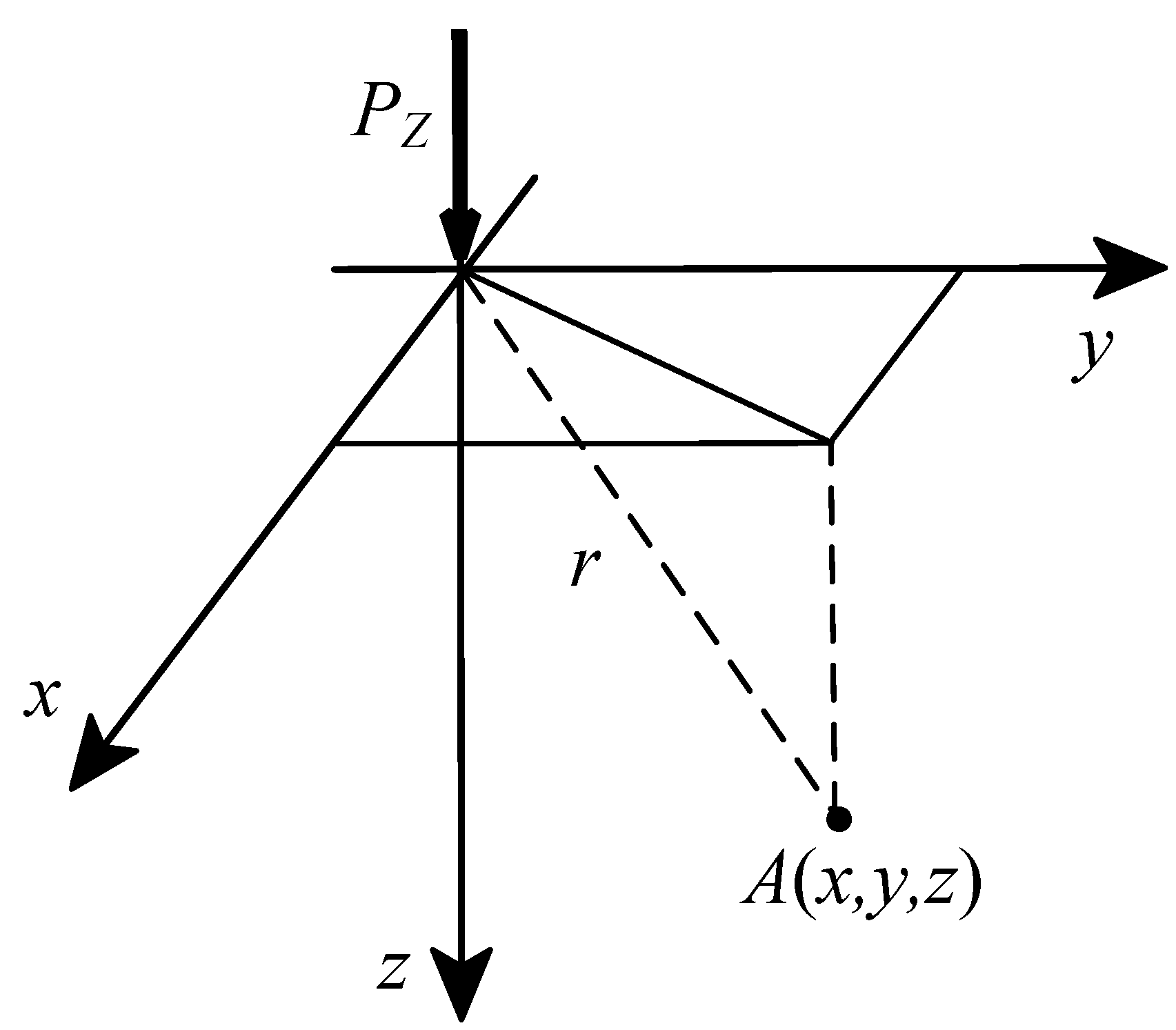
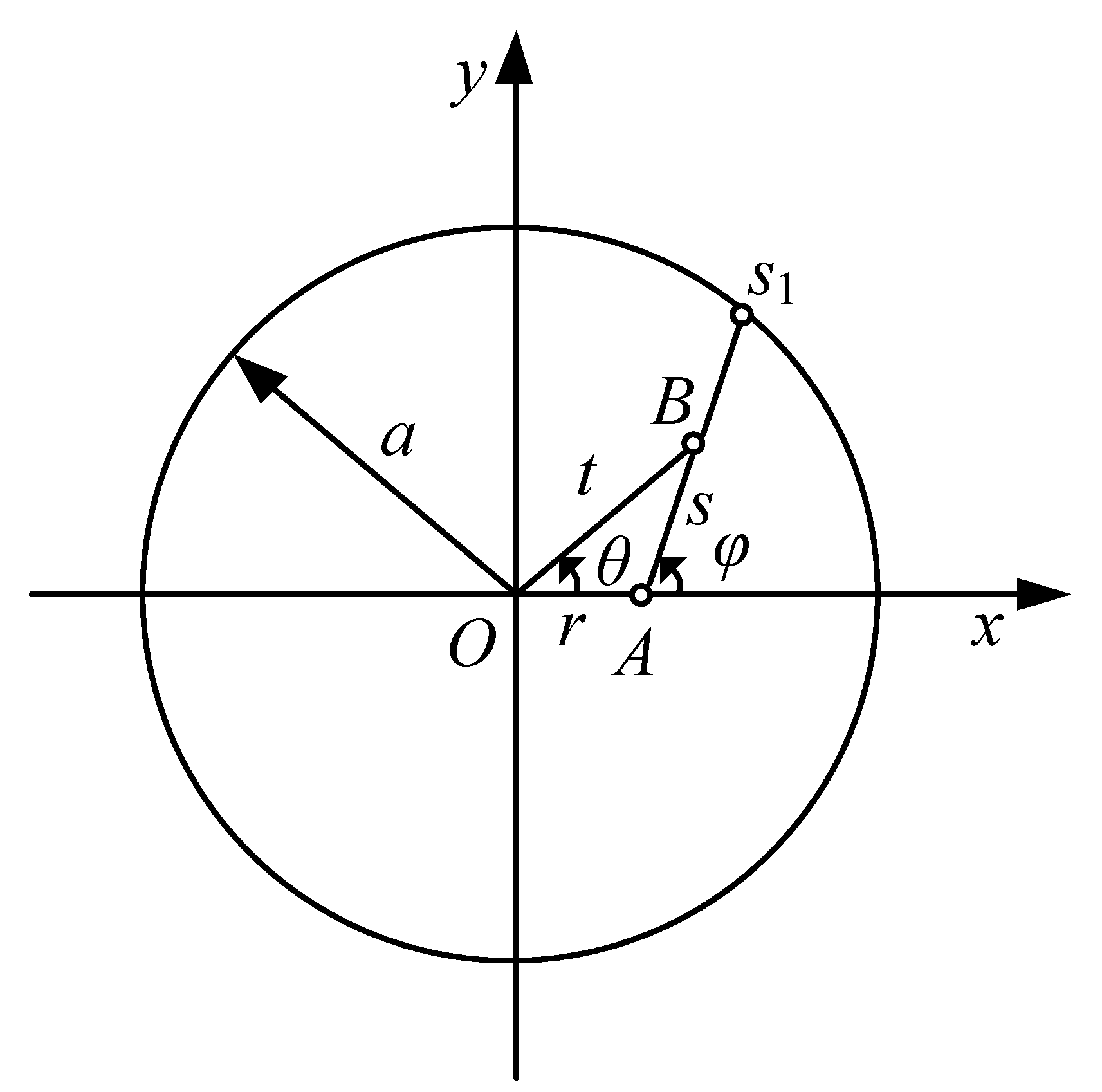

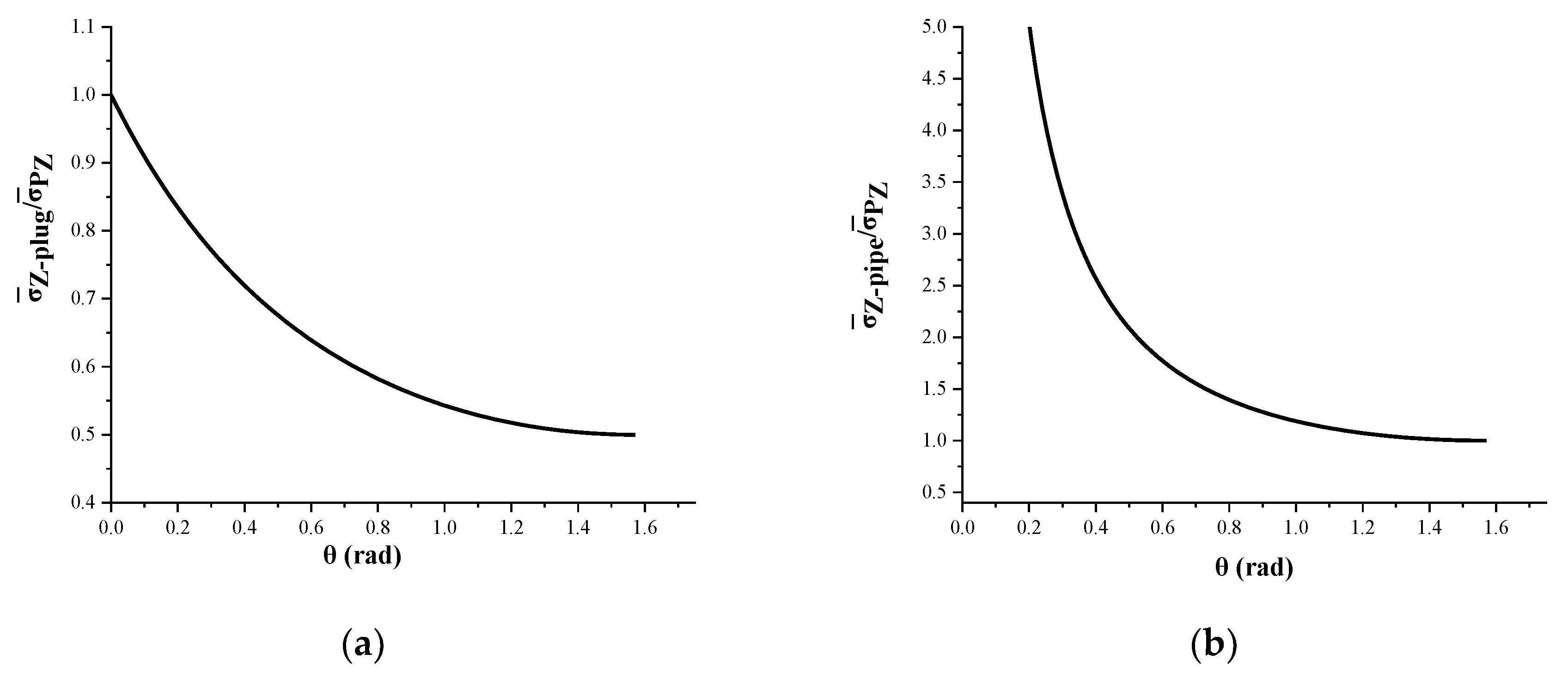
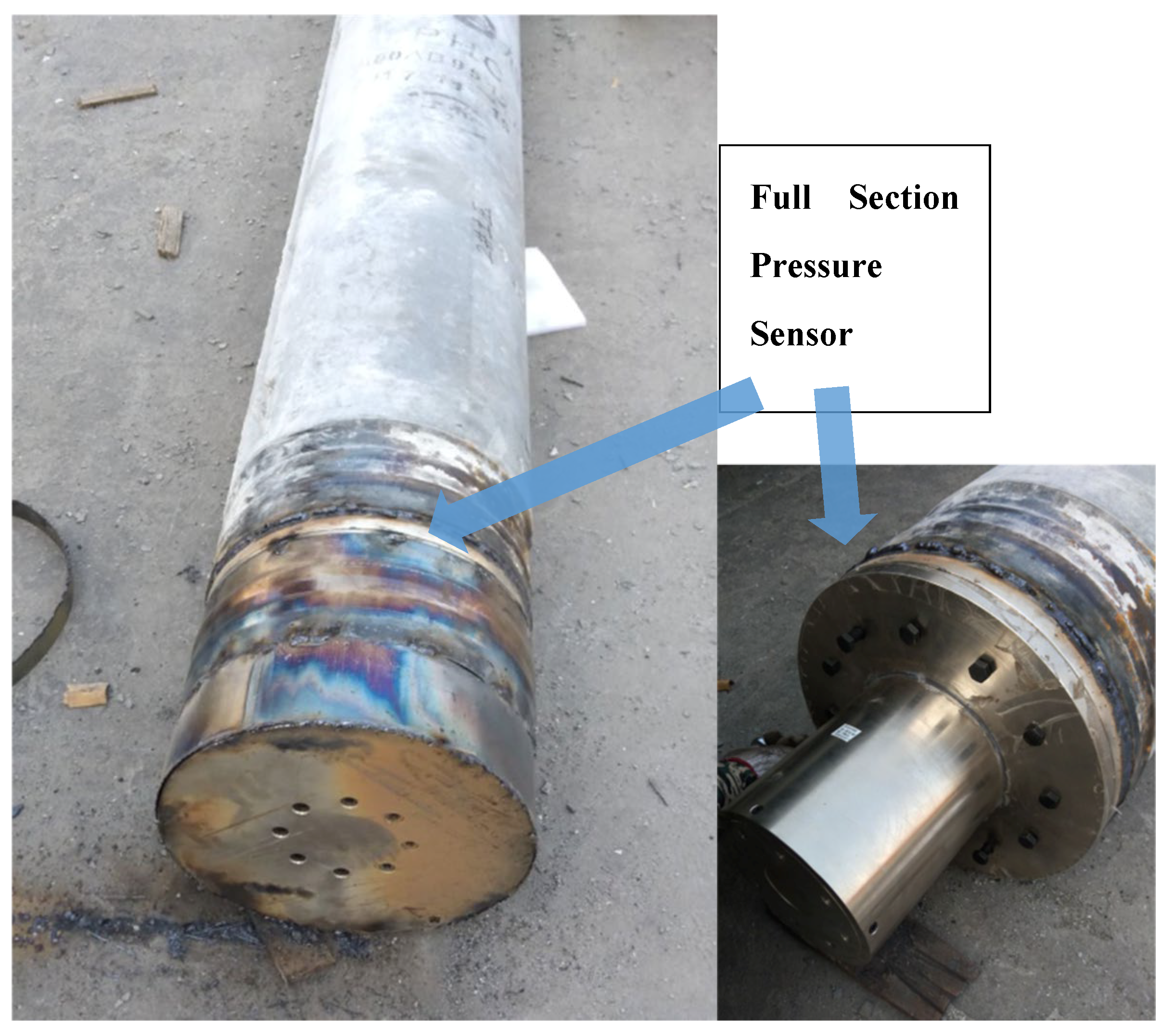
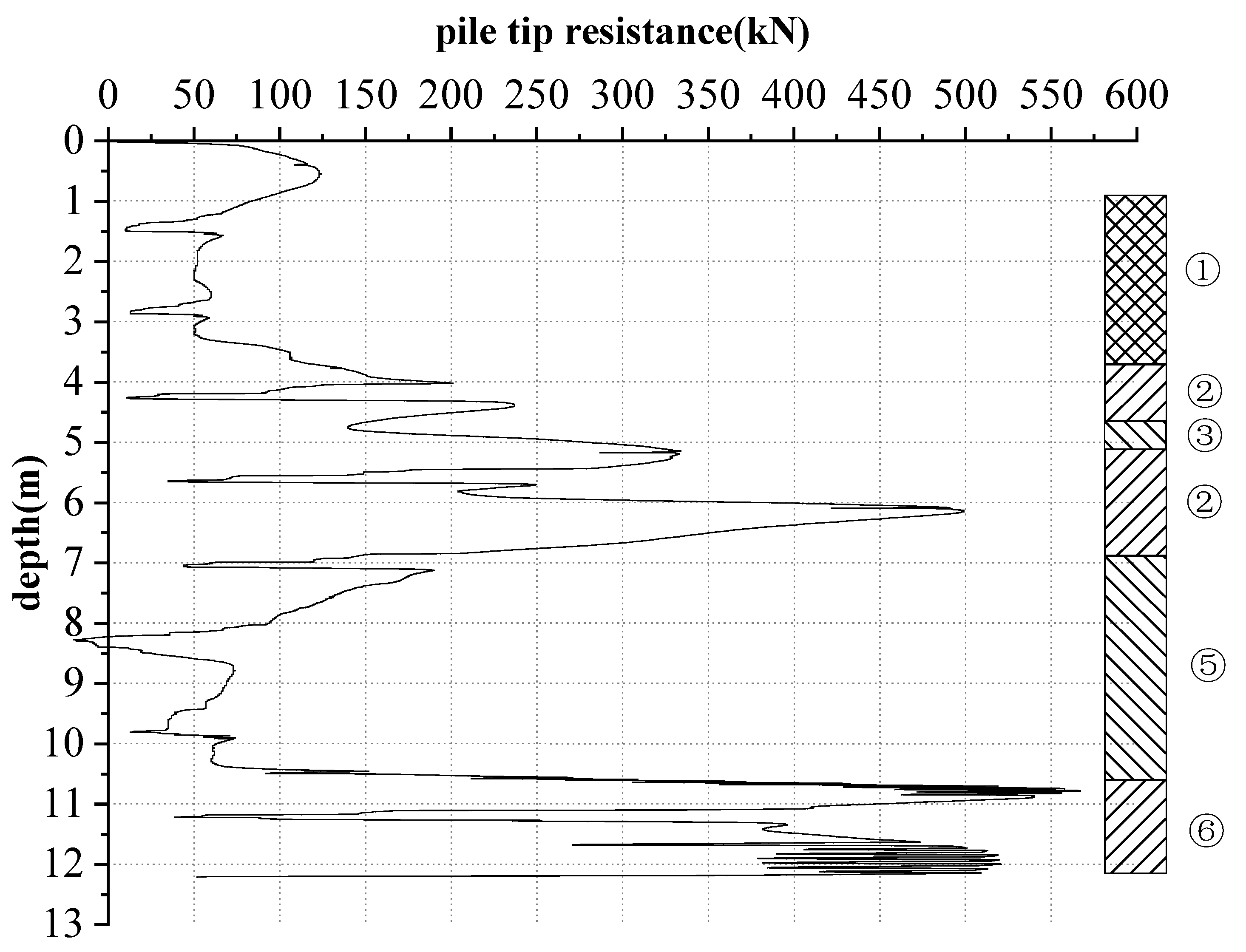
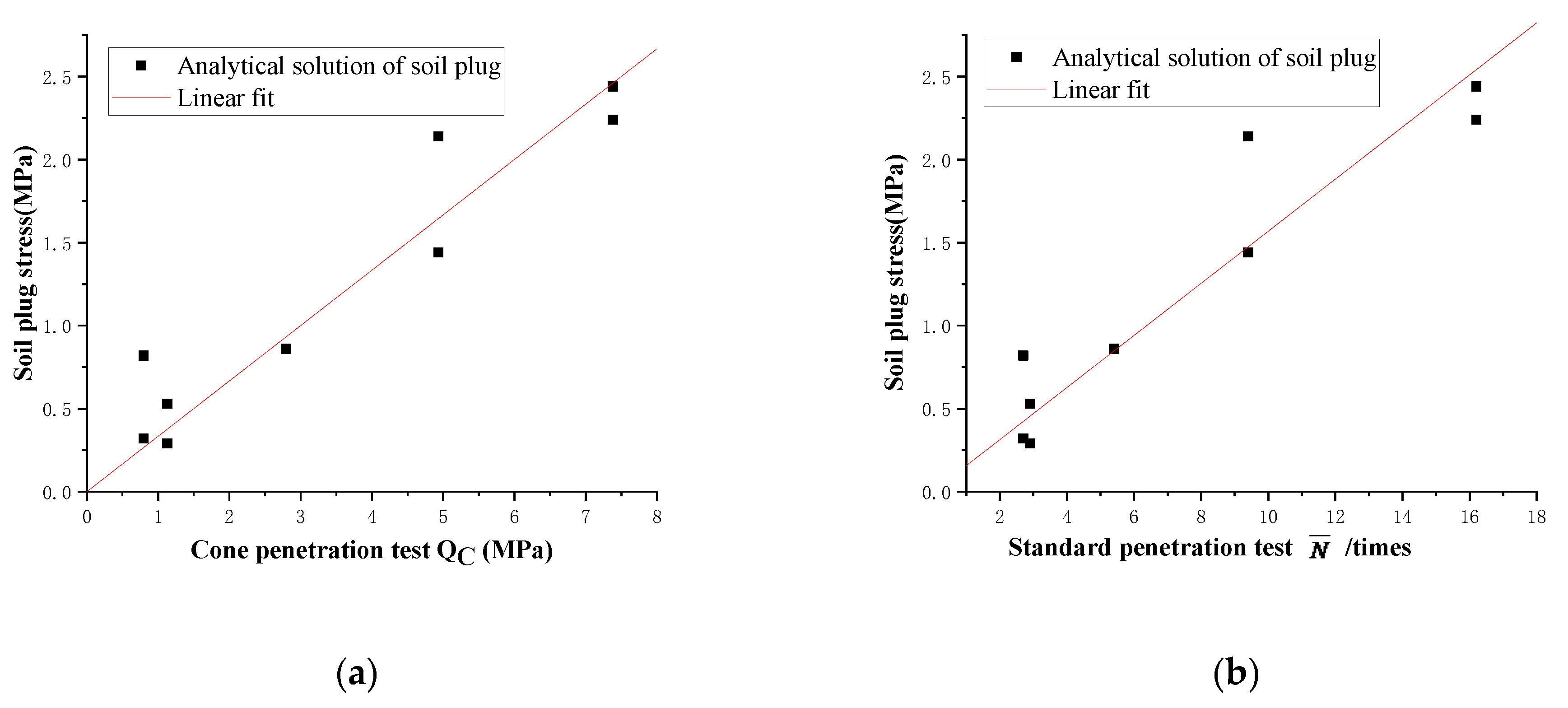
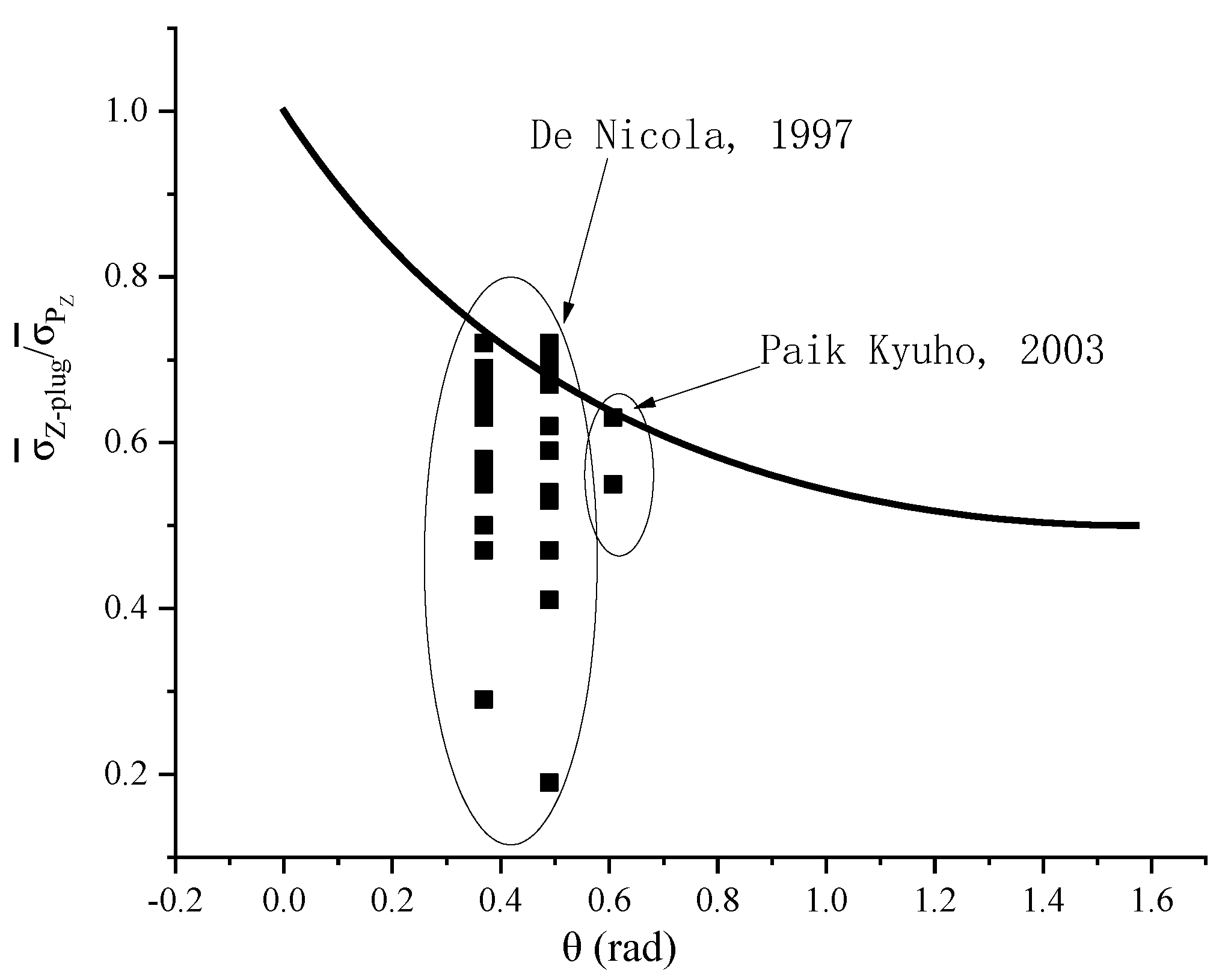
| Depth/m | Soil Layer | Compression Modulus Es1-2 /MPa | Void Ratio e | Water Content w/% | Cone Penetration Test QC/MPa | /Times |
|---|---|---|---|---|---|---|
| 0–3.08 | ①Plain fill(q4ml) | 4.19 | 0.867 | 30.4 | 1.130 | 2.9 |
| 3.08–4.58 | ②Silt(q4al) | 8.55 | 0.803 | 27.7 | 2.796 | 5.4 |
| 4.58–5.08 | ③Silty clay(q4al) | 4.90 | 0.876 | 30.5 | 0.928 | 3.4 |
| 5.08–6.98 | ④Silt(q4al) | 9.11 | 0.794 | 28.0 | 4.930 | 9.4 |
| 6.98–10.38 | ⑤Silty clay(q4al) | 4.67 | 0.895 | 31.5 | 0.799 | 2.7 |
| 10.38–13.88 | ⑥Silt(q4al) | 10.54 | 0.793 | 28.0 | 7.379 | 16.2 |
| Pile Penetration Stroke | Peak Penetration Resistance/kN | Analytical Solution of Soil Plug/kN | Through the Soil Layer | Soil Layer at Pile Tip | Cone Penetration Test QC/MPa | /Times |
|---|---|---|---|---|---|---|
| Stroke 1 | 124(0.99) 1 | 106(0.53) | ① | ① | 1.130 | 2.9 |
| Stroke 2 | 67(0.53) | 57(0.29) | ① | ① | 1.130 | 2.9 |
| Stroke 3 | 201(1.60) | 171(1.86) | ①② | ② | 2.796 | 5.4 |
| Stroke 4 | 334(2.66) | 284(1.44) | ②–④ | ④ | 4.93 | 9.4 |
| Stroke 5 | 499(3.97) | 425(2.14) | ④ | ④ | 4.93 | 9.4 |
| Stroke 6 | 190(1.51) | 162(0.82) | ④⑤ | ⑤ | 0.799 | 2.7 |
| Stroke 7 | 74(0.59) | 63(0.32) | ⑤ | ⑤ | 0.799 | 2.7 |
| Stroke 8 | 567(4.51) | 483(2.44) | ⑤⑥ | ⑥ | 7.379 | 16.2 |
| Stroke 9 | 521(4.15) | 443(2.24) | ⑥ | ⑥ | 7.379 | 16.2 |
| Internal Diameter (mm) | Outer Diameter (mm) | Pipe Thickness (mm) | a (mm) | b (mm) | c (mm) | sinθ |
|---|---|---|---|---|---|---|
| 14.9 | 16 | 0.55 | 8 | 7.45 | 2.92 | 0.36 |
| Pipe stress (MPa) | Soil plug stress (MPa) | Total stress (MPa) | Test value of soil plug to total stress ratio | Theoretical value of soil plug to total stress ratio | Test value of pipe to total stress ratio | Theoretical value of pipe to total stress ratio |
| 8.45 | 2.04 | 4.06 | 0.50 | 0.73 | 2.08 | 2.74 |
| 8.54 | 3.8 | 5.29 | 0.72 | 1.61 | ||
| 4.9 | 0.56 | 1.93 | 0.29 | 2.54 | ||
| 7.37 | 2.06 | 3.73 | 0.55 | 1.98 | ||
| 7.52 | 2.54 | 4.42 | 0.57 | 1.70 | ||
| 11.91 | 3.64 | 6.24 | 0.58 | 1.91 | ||
| 10.22 | 3.89 | 5.88 | 0.66 | 1.74 | ||
| 14.29 | 3.07 | 6.6 | 0.47 | 2.17 | ||
| 11.91 | 4.88 | 7.09 | 0.69 | 1.68 | ||
| 8.56 | 2.06 | 4.11 | 0.50 | 2.08 | ||
| 12.97 | 3.95 | 6.79 | 0.58 | 1.91 | ||
| 23.23 | 8.55 | 13.17 | 0.65 | 1.76 | ||
| 25.98 | 10.06 | 15.07 | 0.67 | 1.72 | ||
| 23.72 | 8.38 | 13.21 | 0.63 | 1.80 |
| Internal Diameter (mm) | Outer Diameter (mm) | Pipe Thickness (mm) | a (mm) | b (mm) | c (mm) |
|---|---|---|---|---|---|
| 14.1 | 16 | 0.95 | 8 | 7.05 | 3.78 |
| Pipe stress (MPa) | Soil plug stress (MPa) | Total stress (MPa) | Test value of soil plug to total stress ratio | Theoretical value of soil plug to total stress ratio | Test value of pipe to total stress ratio |
| 4.9 | 0.4 | 2.14 | 0.19 | 0.68 | 2.29 |
| 7.37 | 2.24 | 4.22 | 0.53 | 1.75 | |
| 8.54 | 2.2 | 4.65 | 0.47 | 1.84 | |
| 8.51 | 4.14 | 5.83 | 0.71 | 1.46 | |
| 10.25 | 2.2 | 5.31 | 0.41 | 1.93 | |
| 14.34 | 1.2 | 6.28 | 0.19 | 2.28 | |
| 11.91 | 4.59 | 7.42 | 0.62 | 1.61 | |
| 11.91 | 4.25 | 7.21 | 0.59 | 1.65 | |
| 23.62 | 7.47 | 13.71 | 0.54 | 1.72 | |
| 23.61 | 11.73 | 16.32 | 0.72 | 1.45 | |
| 8.32 | 3.81 | 5.55 | 0.69 | 1.50 | |
| 12.66 | 5.5 | 8.27 | 0.67 | 1.53 | |
| 23.74 | 10.7 | 15.74 | 0.68 | 1.51 |
| Internal Diameter (mm) | Outer Diameter (mm) | Pipe Thickness (mm) | a (mm) | b (mm) | c (mm) | sinθ |
|---|---|---|---|---|---|---|
| 292 | 356 | 32 | 178 | 146 | 101.82 | 0.57 |
| Pipe stress (MPa) | Soil plug stress (MPa) | Total stress (MPa) | Test value of soil plug to total stress ratio | Theoretical value of soil plug to total stress ratio | Test value of pipe stress to total stress ratio | Theoretical value of pipe stress to total stress ratio |
| 17.59 | 5.02 | 9.13 | 0.55 | 0.64 | 1.93 | 1.75 |
| 13.82 | 3.96 | 7.18 | 0.55 | 1.50 | ||
| 15.75 | 5.57 | 8.90 | 0.63 | 1.77 | ||
| 18.70 | 5.35 | 9.71 | 0.55 | 1.92 | ||
| 22.01 | 6.29 | 11.43 | 0.55 | 1.93 |
© 2020 by the authors. Licensee MDPI, Basel, Switzerland. This article is an open access article distributed under the terms and conditions of the Creative Commons Attribution (CC BY) license (http://creativecommons.org/licenses/by/4.0/).
Share and Cite
Yang, S.; Liu, J.; Garg, A.; Zhang, M. Analytical Solution for Estimating Bearing Capacity of a Closed Soil Plug: Verification Using An On-Site Static Pile Test. J. Mar. Sci. Eng. 2020, 8, 490. https://doi.org/10.3390/jmse8070490
Yang S, Liu J, Garg A, Zhang M. Analytical Solution for Estimating Bearing Capacity of a Closed Soil Plug: Verification Using An On-Site Static Pile Test. Journal of Marine Science and Engineering. 2020; 8(7):490. https://doi.org/10.3390/jmse8070490
Chicago/Turabian StyleYang, Suchun, Junwei Liu, Ankit Garg, and Mingyi Zhang. 2020. "Analytical Solution for Estimating Bearing Capacity of a Closed Soil Plug: Verification Using An On-Site Static Pile Test" Journal of Marine Science and Engineering 8, no. 7: 490. https://doi.org/10.3390/jmse8070490
APA StyleYang, S., Liu, J., Garg, A., & Zhang, M. (2020). Analytical Solution for Estimating Bearing Capacity of a Closed Soil Plug: Verification Using An On-Site Static Pile Test. Journal of Marine Science and Engineering, 8(7), 490. https://doi.org/10.3390/jmse8070490






